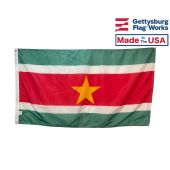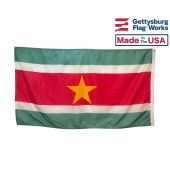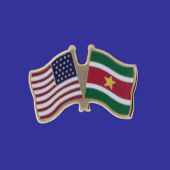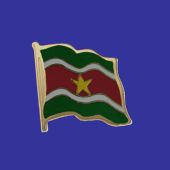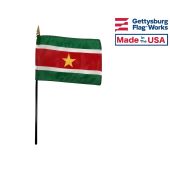Buy Suriname Flags

Flag of Suriname
The history of the Suriname flag begins during the colonial period, but the modern flag of Suriname bears almost not resemblance to any of the nation's historical flags. Suriname has traditionally adopted new flags that are highly divergent from historical designs, which has led to a great deal of variety in the nation's vexillological history in spite of the fact that the nation has used relatively few flags over the course of its history.
- Capital of Suriname: Paramaribo
- Area of Suriname: 161,470 sq. km
- Languages used in Suriname: Dutch (official), English, Sranang Tongo, Hindustani, Javanese
- Religions in Suriname: Hindu, Protestant, Roman Catholic, Muslim, indigenous beliefs
Colors and Symbolism of the Suriname Flag
The flag of Suriname is made of five horizontal stripes. The central stripe is red and is significantly thicker than the other stripes. It is sandwiched between two thing stripes of white, which are followed by stripes of green. A yellow star with five points is placed in the center of the flag.
The star serves as a symbol of all of the different ethic groups that make up the population of Suriname, while the stripes stand for virtues that the people of Suriname value. The red stripe represents love and progress, the white stripes represent justice and peace, and the green stripes stand for fertility and hope.
History of the Flag of Suriname
The modern nation of Suriname began as part of the Dutch Empire, so it was initially represented by the flag of the Netherlands. The flag consisted of three horizontal stripes of red, white, and blue. The flag remained in use from the time that the colony was founded in 1667 until Suriname began to work towards independence during the 20th century. Suriname became an autonomous part of the Kingdom of the Netherlands before it became a fully independent nation, which led to the adoption of the first unique Suriname flag in 1959. The flag's design featured five stars of red, yellow, brown, black, and white that were placed along a black ring upon a white field. The stars were intended to represent the nation's different ethnic groups, a role which is fulfilled by the single star on the current flag. The single star is the only reference that the modern flag has to the previous design, which it replaced in 1975.
